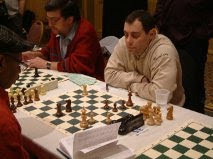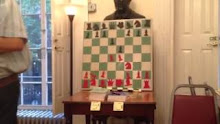Karpov's most recent mortal thrust to the Dragon occurred last autumn* at the 27th World Chess Olympiad where he introduced 15.g4! against the heretofore solid Soltis formation with 12...h5. Since then, Soltis's line has been in a state of crisis.
Before the Dragon is prematurely pronounced dead, however, it should be noted that the variation's leading author/practitioner Anthony Miles has made an attempt to pump new life into the 13...Nh7 line by means of 16...Qc7, instead of the more usual 16...Qa5. (See Illustrative Game #1.)
Most of the notes that follow have been gleaned from Robert Byrne's chess column in The New York Times, with the exception of my 31.exd5! in the analysis to White's 21st move in Illustrative Game #5. And, of course, the annotations to Illustrative Game #6 are entirely my own unless noted otherwise.
Illustrative Game #1
Lobron-Miles, Biel 1986
1.e4 c5 2.Nf3 d6 3.d4 cxd4 4.Nxd4 Nf6 5.Nc3 g6 6.Be3 Bg7 7.f3 O-O 8.Qd2 Nc6 9.Bc4 Bd7 10.h4 Rc8 11.Bb3 h5 12.O-O-O Ne5
13.Bg5 Nh7 14.Bh6 Bxh6 15.Qxh6 Rxc3 16.bxc3 Qc7 17.Kb1 Nc4 18.g4 hxg4 19.f4
If instead 19.h5?, then 19...g5.
19...Rc8 20.Rd3
Not 20.h5? because of 20...Na3+ 21.Kb2 Qxc3+! 22.Kxa3 Rc5! followed by 23...Ra5#.
20...Qa5 21.h5 g5 22.e5 dxe5 23.Bxc4
In Black's favor is 23.fxg5? exd4 24.g6 Nf6 25.Rf1 Qxh5 26.Rxf6 Qxh6 27.gxf7+ Kg7 28.Rxh6 Kxh6 29.Bxc4 Bf5 30.Rxd4 g3.
23...Rxc4 24.Nb3 Qc7 25.fxg5 Bf5 26.g6 Nf6?
Better is 26...Nf8 27.Rf1 Rf4.
27.Rd2 Rxc3 28.Rhd1! Bxc2+
Or 28...Bd7 29.Rxd7!.
29.Rxc2 Rxc2 30.gxf7+ Kxf7 31.Qg6+ Ke6 32.Qxc2 Qxc2+ 33.Kxc2 Nxh5 34.Kd2 Kf5 35.Ke3 g3 36.Nd2 Kg4 37.Nf3 g2 38.Kf2 Nf4
39.Nxe5+ Kh3 40.Rd8 Kh2 41.Nf3+ Kh3 42.Ng1+ Kg4 43.Rd7, Black resigns.
* * * * * * * * * * * * * *
Illustrative Game #2
Karpov-Sznapik, Dubai 1986
1.e4 c5 2.Nf3 d6 3.d4 cxd4 4.Nxd4 Nf6 5.Nc3 g6 6.Be3 Bg7 7.f3 O-O 8.Qd2 Nc6 9.Bc4 Bd7 10.O-O-O Ne5 11.Bb3 Rc8 12.h4 h5 13.Bg5 Rc5 14.Kb1 b5 15.g4!
15...hxg4
Worthy of consideration is 15...a5!? 16.Bxf6 Bxf6 17.a3 hxg4 18.f4 Nc4 19.Qd3 Qc8 20.Nd5 Rxd5!? 21.exd5 Bf5 =.
16.h5 Nxh5 17.Nd5 Re8
Bad is 17...Nf6? 18.Qh2 Re8 19.Qh4 followed by 20.Rh2, 21.Rdh1, and 22.Qh8+ forcing mate.
18.Rxh5! gxh5 19.Qh2 Rc4 20.Bxc4 bxc4 21.Qxh5 f6 22.f4 Nf7
On 22...fxg5, White wins by 23.fxe5 dxe5 (23...e6 24.Rh1!) 24.Nf5! Bxf5 (24...e6 25.Nh6+ Bxh6 26.Qxh6 exd5 27.Qg6+ forces mate) 25.exf5 Qc8 26.Qg6 with 27.f6! to follow.
23.Bh4 Qb8 24.Rh1 c3 25.b3 Qb7 26.f5 Ne5 27.Ne6, Black resigns.
The threat is 28.Bxf6!.
* * * * * * * * * * * * * *
Illustrative Game #3
Chandler-Mestel, British Championship Playoff 1986
1.e4 c5 2.Nf3 d6 3.d4 cxd4 4.Nxd4 Nf6 5.Nc3 g6 6.Be3 Bg7 7.f3 O-O 8.Qd2 Nc6 9.Bc4 Bd7 10.O-O-O Ne5 11.Bb3 Rc8 12.h4 h5 13.Bg5 Rc5 14.Kb1 b5 15.g4! hxg4 16.h5 Nxh5 17.Nd5 Re8 18.Rxh5! gxh5 19.Qh2 Rxd5
20.Bxd5 Qb6 21.Qxh5 e6 22.Bb3 Qc5 23.Bh6 Bf6 24.f4 Ng6
25.Nf5! Bc6
The move 25...exf5? allows 26.Qxg6+.
26.Qxg4 d5 27.Ng3 Qe3
But not 27...dxe4? 28.f5 exf5? 29.Qxg6+.
28.e5?!
White should play 28.Nh5 Bh8 29.exd5 exd5 30.Bxd5 Bxd5 31.Rxd5 Qh3 32.Qd1 Qh4 33.Bg5 Qf2 34.Rd8.
28...Bxe5! 29.fxe5 Qxh6 30.Nh5 Rc8?
Black misses 30...Kf8! 31.Qb4+ Re7 32.Nf6 Qf4 (32...Nxe5? 33.Qxe7+! Kxe7 34.Ng8+) 33.Qc5 Qxe5 34.Qxc6 Qxf6 35.Bxd5 Qe5.
31.c3! Qe3? 32.Bc2 Kf8
Or 32...Qxe5? 33.Rf1! Be8 34.Nf6+ Kg7 35.Bxg6 fxg6 36.Qh4 Bf7 37.Qh7+ Kb8 38.Nd7+.
33.Bxg6 fxg6 34.Rf1+ Ke7 35.Qb4+ Kd8 36.Qd6+, Black resigns.
* * * * * * * * * * * * * *
Illustrative Game #4
Short-Olafsson, Wijk-aan-Zee 1987
1.e4 c5 2.Nf3 d6 3.d4 cxd4 4.Nxd4 Nf6 5.Nc3 g6 6.Be3 Bg7 7.f3 O-O 8.Qd2 Nc6 9.Bc4 Bd7 10.h4 Rc8 11.Bb3 h5 12.O-O-O Ne5 13.Bh6
More usual is 13.Bg5 Nh7 and only then 14.Bh6.
13...Bxh6 14.Qxh6 Rxc3 15.bxc3 Qc7 16.Kb1 a5
Not to be recommended is 16...Qxc3 17.Ne2 Qc5 18.Nf4 e6 (18...Nc4? 19.Nxg6! fxg6 20.Qxg6+ Kh8 21.Qh6+ Nh7 22.Rd5 Qc7 23.Rxh5 Rf7 24.Rg5 Nd2+ 25.Kb2 Nxb3 26.Qg6! Nxg5 27.hxg5+ followed by mate) 19.Qg5 Kg7 20.Nd3 Nxd3 21.Rxd3 Bb5 22.Qxc5 dxc5 with a winning endgame for White.
17.f4 Nfg4
On 17...Nc4?, White plays 18.f5!.
18.Qg5 a4 19.fxe5 axb3 20.cxb3 Nf2 21.e6!
This is better than 21.exd6 exd6 22.Qe3 Nxh1 23.Rxh1 Re8 with counterplay.
21...Nxe4 22.Qh6 Nxc3+ 23.Kb2 Nxd1+
The alternative 23...Ra8? fails to 24.exf7+ Kxf7 25.Qh7+ Kf6 26.Rhf1+ Bf5 27.Rxf5+ gxf5 28.Qxf5+ Kg7 29.Ne6+.
24.Rxd1 fxe6
Clearly better for White is 24...Be8 25.exf7+ Bxf7 26.Ne6! Bxe6 27.Qxg6+ Kh8 28.Qh6+ Kg8 29.Qxe6+ Kg7 30.Rc1! Qd8 31.Qd5.
25.Qxg6+ Kh8 26.Qxh5+ Kg8 27.Qg6+ Kh8 28.Qh6+ Kg8 29.Qg5+! Kh8 30.Rc1 Qb6
31.Qh6+ Kg8 32.Qg6+ Kh8 33.Nxe6 Qf2+ 34.Rc2 Qf6+ 35.Qxf6+ Rxf6 36.Nd8 b5
37.Rc7 Rf2+ 38.Ka3 Bg4 39.Rxe7 Kg8 40.Ne6 Kh8 41.g3 Rg2 42.Nd4 Rxg3 43.Nxb5 d5
44.Kb4 Rh3 45.Nd4 Rxh4 46.Kc5 Rh2 47.a4 Ra2 48.Ra7, Black resigns.
* * * * * * * * * * * * * *
Illustrative Game #5
Mestel-Kudrin, Hastings 1986-1987
1.e4 c5 2.Nf3 d6 3.d4 cxd4 4.Nxd4 Nf6 5.Nc3 g6 6.Be3 Bg7 7.f3 Nc6 8.Qd2 O-O 9.Bc4 Bd7 10.O-O-O Ne5 11.Bb3 Rc8 12.h4 h5 13.Bg5 Rc5 14.Kb1 b5 15.g4! a5 16.Bxf6 Bxf6 17.gxh5!?
This is more ambitious than 17.a3 hxg4 18.f4 Nc4 19.Qd3 Qc8 20.Nd5 Rxd5!? 21.exd5 Bf5 =, Karpov-Georgiev, Dubai 1986.
17...a4 18.Bd5!?
The move 18.hxg6?! proved unsuccessful for White after 18...axb3 in Chandler-Petursson, Hastings 1986-1987.
18...e6 19.hxg6 exd5 20.h5 Rxc3 21.bxc3
Winning for Black is 21.Qxc3?! Nc4 22.Qe1 Qa5 23.Qg3? Qb4.
Byrne also gives "the slightly fantastic 21.Rdg1!?, but after 21...fxg6 22.hxg6 Rc7 23.Nf5! Be6 (23...Bxf5 24.Qxd5+ is annihilating) 24.g7! Rxg7 25.Nh6+ Kh8 26.Nf7+ Kg8 27.Nxd8 Rxd8 28.Qh6 Rxg1+ 29.Rxg1+ Kf7 30.Qh7+ Kf8 31.f4 Nd7, Black is maintaining himself."
But better than 31.f4?! is 31.exd5!. Now 31...Bxd5? is disallowed because of 32.Qf5 Ke7 33.f4 Be6 34.Qh7+ Nf7 35.Re1 Kd7 36.Qg6 Ke7 37.Qf5 Ne5 38.Qe4 which wins for White.
21...Bg5! 22.f4 Bh6 23.Rdg1 Qe7
Unclear is 23...dxe4 24.gxf7+ Kh8 25.Qg2 Nxf7 26.Qxe4.
24.Qg2 Bxf4
On 24...Ng4, White wins with 25.Nf5! Qxe4 26.Nxh6+ Nxh6 27.gxf7+ Kxf7 28.Qg7+.
25.g7 Rb8 26.h6 Ng6 27.Nf5! Bxf5 28.exf5 Qe5
No better is 28...Nh4 29.h7+ Kxh7 30.g8=Q+ with mate to follow.
29.fxg6 f5, Black forfeits.
White was winning anyway with 30.Re1 Be3 31.Rxe3! Qxe3 32.Qxd5+.
* * * * * * * * * * * * * *
Illustrative Game #6
Jim West (national master) - Robert Isaacs (candidate master), Somerset NJ Quad 3/1987
1.e4 c5 2.Nf3 d6 3.d4 cxd4 4.Nxd4 Nf6 5.Nc3 g6 6.Be3 Bg7 7.f3 O-O 8.Qd2 Nc6 9.Bc4 Bd7 10.h4 Ne5 11.Bb3 h5 12.O-O-O Rc8 13.Bg5 Rc5 14.Kb1 b5 15.g4! hxg4 16.h5 Nxh5 17.Nd5 Rxd5 18.Bxd5 Nc4
If 18...gxf3, Byrne gives 19.Nf5!.
19.Qg2 Qb6 20.c3 e6
The continuation 20...gxf3 21.Nxf3 e6? loses to 22.Bxc4 bxc4 23.Rxh5! gxh5 24.Bf6.
21.fxg4 Nf6 22.Qh2 Rb8 23.Bxf6 Bxf6 24.Rdf1 Bg7 25.Nxe6! Bxe6 26.Bxe6 Ne5
Obviously not 26...fxe6?? 27.Qh7#.
27.Bxf7+! Nxf7 28.Qh7+ Kf8 29.Qxg6 Rb7
White wins material after 29...Qc7 30.Rxf7+! Qxf7 31.Qxd6+ followed by 32.Qxb8+.
30.Rh7 Qe3 31.Qxg7+ Ke8 32.Rh8+, Black resigns.
*{This article originally appeared in Atlantic Chess News in 1987}




























